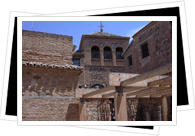History of Toledo, Spain
 Archaeological remains prove that prehistoric Iberians inhabited the area where Toledo now lies. This comes as no surprise when you consider the geographical position of the city: it rests on a hill 100 meters above the Tajo River. The area's strategic elevation and proximity to the Tajo have long made Toletum/ Tulaytulah/ Tolétho/ Toledo an attractive place to live by whatever name.
Archaeological remains prove that prehistoric Iberians inhabited the area where Toledo now lies. This comes as no surprise when you consider the geographical position of the city: it rests on a hill 100 meters above the Tajo River. The area's strategic elevation and proximity to the Tajo have long made Toletum/ Tulaytulah/ Tolétho/ Toledo an attractive place to live by whatever name.
The Romans moved into "Toletum" around 193 BC; however unlike other cities from this period such as Segovia, there is no significant surviving evidence of their presence. Toledo's convenient location in the center of the peninsula made it an important trade crossroads. It also became a hub for iron production at this time, a trade that would continue to thrive for centuries.
The Visigoths moved their capital here from the southern city of Sevilla during the 5th century AD. This was a crucial era in Toledo's history, since Visigoth nobles held various religious councils that unified disparate tribes under a single religion - Christianity - and a more or less centralized government. Nevertheless, when the Arabs crossed the Strait of Gibraltar in 711 AD, they quickly arrived in Toledo just one year later and easily conquered the city.
The Muslims ushered in Toledo's resplendent medieval period, a time of unparalleled prosperity and cultural advancement. Jews, Christians and Muslims lived in harmony from this time until the Inquisition, thus Toledo's nickname "La ciudad de las tres culturas" ("the city of 3 cultures").
The Catholics took back Toledo in 1041 and it became the official capital of Castile. Despite the change in religious leaders, peaceful coexistence continued and reached its apogee under Alfonso X, or Alfonso "The Wise." He placed special importance on the city's unique translation school, which disseminated Greek classics and otherwise unknown scientific texts throughout the Western world.
Toledo's golden age fell into decline under the Catholic Kings' unification of Spain and the subsequent onset of the Inquisition. King Ferdinand and Queen Isabel thwarted religious tolerance, which had been inextricably linked to Toledo's prosperity. Jews and Muslims, two great cultural and economic contributors to Toledo society, were forced to convert or leave the country.
Phillip II stripped Toledo of its capital status in 1561 when he moved his court to Madrid. The city's former glory was largely left by the wayside until modern-day tourism rekindled interest in Toledo's history and stunning beauty.
